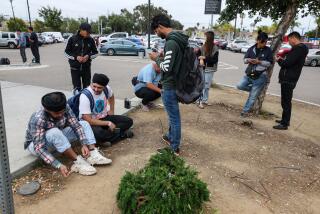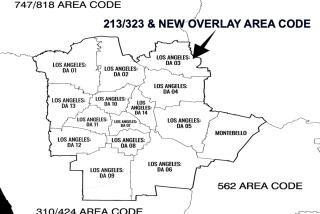PUC Rejects ‘Overlays’ for New Area Codes
- Share via
In a decision that will require millions of Californians to change telephone numbers over the next few years, the state Public Utilities Commission ruled Friday that area codes running out of capacity--including 213, 310, 818 and 714--must be split geographically.
The commission rejected until 2001 “overlay” plans in which new area codes would have been introduced within the same geographic boundaries as existing codes, adding capacity without forcing customers to change. The ruling was a setback for Pacific Bell, which had fought for the overlay option.
Explaining the ruling, the commission cited surveys showing that most consumers prefer area code splits to overlays.
In a written statement, the commission said that “the greatest concerns about an overlay are having a mix of codes within the same household or business.” Further, overlays require customers to dial 11 digits even on calls in their area code.
PUC officials could not be reached for additional comment.
Overlay plans assign new area codes to each newly installed phone, regardless of its location. Such plans have never been implemented in California, but have been used in New York and have been approved in other states, including Pennsylvania and Maryland, officials said.
Critics of geographic splits--which assign a new code to roughly half of the existing customers in a region--cite the disruption they cause, particularly in heavily populated regions where codes are splintering rapidly.
“You have the possibility in Los Angeles County today of having one area code where you live, another where your kids go to school, and yet a third where you work,” said Pacific Bell spokesman Dave Miller. “Pretty soon, you’re not going to know what’s up and what’s down.”
Businesses located in areas targeted for new codes also often complain, saying they have to notify customers and incur costs updating their business cards and stationery.
The decision will have a dramatic impact in Southern California, where population growth combined with the proliferation of fax machines, cellular phones, computer modems, pagers and other devices has created an acute shortage of available phone numbers.
At least four area codes in Southern California are scheduled to be split over the next two years, including 714 in Orange County and 213, 310 and 818 in Los Angeles County. The 310 and 818 codes are products of a 213 code split in 1984. Miller said 310 is scheduled to undergo another split as early as 2002.
The commission’s ruling is bound to please long-distance carriers, cable television companies and others that, in the wake of telecommunications deregulation, are rushing to offer local phone service. Such companies had fought overlay plans on the grounds that customers would be reluctant to switch phone companies if it also meant switching to a new area code.
In a measure of how thorny an issue area code splits have become, officials from Burbank, Glendale and several other cities recently lobbied PUC commissioners to be excluded from a new 626 area code planned for the San Gabriel Valley. The city officials cited their ties to the San Fernando Valley and its 818 area code.
More to Read
Sign up for Essential California
The most important California stories and recommendations in your inbox every morning.
You may occasionally receive promotional content from the Los Angeles Times.













